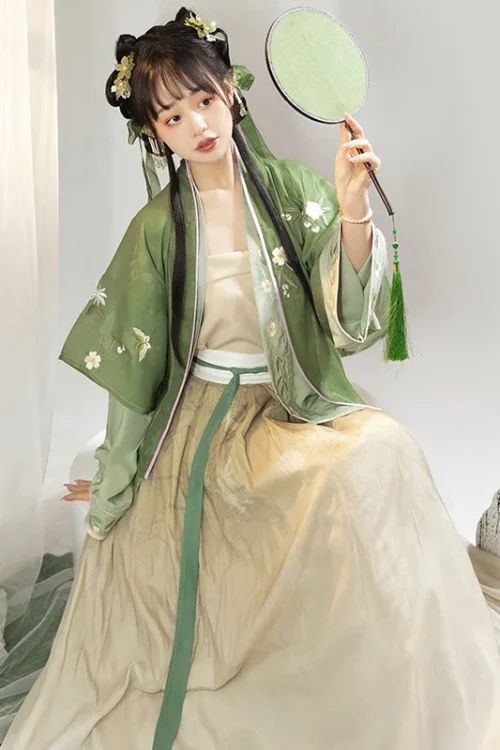Song Dynasty Hanfu: Key Features
Identifying Hanfu from the Song Dynasty requires a keen eye for its distinctive features. During this era, Hanfu underwent significant changes, reflecting the cultural and societal shifts of the time.

Silhouette
One of the most notable characteristics of Song Dynasty Hanfu is its silhouette:
- Women’s Robes (Ruqun): Featured a high waistline and a long, flowing skirt that reached the ground. The bodice was typically fitted and often adorned with intricate embroidery or decorative trim.
- Men’s Robes (Changpao): Long and flowing with a more relaxed fit and a lower waistline.
Fabrics and Colors
The fabrics and colors used in Song Dynasty Hanfu were also distinctive:
- Fabrics: Silk was the preferred material, known for its luxury and comfort. Cotton and linen were used for everyday wear.
- Colors: Varied widely, with popular hues including white, blue, green, and yellow.
Sleeves
The sleeves of Song Dynasty Hanfu had unique features:
- Women’s Robes: Often had wide, flowing sleeves that extended beyond the hands, known as “horse-hoof sleeves.”
- Men’s Robes: Had narrower sleeves, typically gathered at the wrists.

Accessori
Accessories also played a role in identifying Song Dynasty Hanfu:
- Women’s Sash (Dai): Made of silk, often decorated with embroidery or tassels.
- Men’s Belt (Dai): Made of leather or fabric, used to secure their robes.
Hairstyles
The hairstyles of the Song Dynasty also provide clues:
- Women: Typically wore their hair in a high bun, often adorned with hairpins or ornaments.
- Men: Wore their hair in styles such as a topknot, ponytail, or shaved head.
Historical Context and Evolution of Hanfu in the Song Dynasty
During the Song Dynasty (960-1279), Hanfu underwent significant changes that reflected the era’s cultural and societal shifts.
Round-Collar Robes (Yuanlingpao)
One of the most notable features of Song Dynasty Hanfu is the prevalence of round-collar robes:
- Design: Featured a wide, round neckline that extended to the shoulders. The sleeves were wide and flowing, creating an elegant and graceful silhouette.
Embroidery and Decorative Patterns
Song Dynasty Hanfu was known for its intricate embroidery:
- Motifs: Common motifs included flowers, birds, and auspicious symbols. The embroidery techniques of this period were highly skilled, resulting in exquisite designs.

Colors
The colors of Song Dynasty Hanfu were generally more subdued:
- Popular Colors: Earth tones such as brown, green, and blue, along with shades of white and gray. These colors reflected the prevailing aesthetic of simplicity and elegance.
Altro Garments
In addition to round-collar robes, other garments included:
- Jiaolingpao: A cross-collar robe with a V-shaped neckline that crossed over at the chest.
- Beizi: A short jacket, typically worn by men, characterized by its short length and wide sleeves.
Fabrics
The primary fabrics used in Song Dynasty Hanfu were:
- Silk: Preferred for formal occasions and outer layers of robes.
- Cotton: Commonly used for inner layers and garments worn by the lower classes.
By understanding these distinctive characteristics, you can accurately identify Hanfu from the Song Dynasty. The round-collar robes, intricate embroidery, subdued colors, and use of silk and cotton are all key indicators of this unique style.
